LIABILITY-EXPANDING LAWS LEAD TO LAWSUIT ABUSE
“Americans With Disabilities Act” Lawsuit Abuse
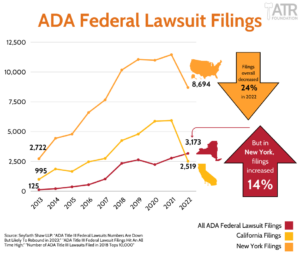 New York has now surpassed California in the number of Americans with Disabilities Act Title III filings. In 2022, 3,173 cases were filed in New York compared with 2,519 in California. The vast majority of these cases are brought in the Southern District of New York, which includes New York City. Through August of 2023, over 70% of the more than 1,500 ADA cases in New York were brought in this district. While earlier ADA cases often asserted that a store’s physical location or parking lot did not meet all accessibility regulations, many of these cases now claim that a business’s website lacks features to assist those who are visually impaired. A plaintiffs’ lawyer or serial plaintiff can look for lawsuits to file on a computer. Of those filed in 2022, 1,660 (70%) were filed in New York. Five law firms, three of which are based in New York, filed more than 66% of the cases. New York, by far, exceeds all other states in hosting these claims in the first half of 2023.
New York has now surpassed California in the number of Americans with Disabilities Act Title III filings. In 2022, 3,173 cases were filed in New York compared with 2,519 in California. The vast majority of these cases are brought in the Southern District of New York, which includes New York City. Through August of 2023, over 70% of the more than 1,500 ADA cases in New York were brought in this district. While earlier ADA cases often asserted that a store’s physical location or parking lot did not meet all accessibility regulations, many of these cases now claim that a business’s website lacks features to assist those who are visually impaired. A plaintiffs’ lawyer or serial plaintiff can look for lawsuits to file on a computer. Of those filed in 2022, 1,660 (70%) were filed in New York. Five law firms, three of which are based in New York, filed more than 66% of the cases. New York, by far, exceeds all other states in hosting these claims in the first half of 2023.
Plaintiffs’ lawyers take advantage of New York’s unique set of disability laws. New York is one of just a few states whose state disability laws go far beyond what the federal Americans with Disabilities Act (ADA) provides. New York does not require a plaintiff to show that a disability “substantially limits” any major life activities. Plaintiffs may also obtain statutory damages that are unavailable under the federal ADA. Few lawsuits are filed by plaintiffs who face real injury from lack of access, and most of these cases are filed by firms and serial plaintiffs who make vague and conclusory allegations about the inaccessibility of websites to those who are visually impaired.
These website accessibility lawsuits are increasingly targeting small businesses. After several years of these lawsuits, plaintiffs’ firms have hit larger companies with website accessibility claims, sometimes multiple times. For that reason, lawyers are not focusing on smaller companies. These businesses are extorted into low-dollar settlements, as the alternative is to spend more money on defense costs.
The high concentration of ADA filings in New York places a serious strain on judicial resources. In 2022, ADA-related case filings accounted for nearly 21% of all the civil cases in the Southern District of New York, which includes New York City.
SCOTUS Seemed Poised to Weigh in on ADA “Serial Testers” … Until They Didn’t
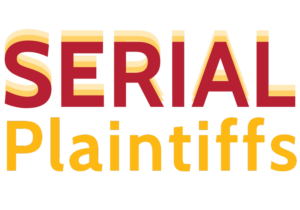 In March 2023, the U.S. Supreme Court agreed to decide whether serial “testers,” individuals who bring suits against numerous entities for alleged violations of the ADA without necessarily planning on using the service, have standing to sue. The question regarding standing turns on whether the plaintiff suffered a “sufficiently concrete injury.” While the case targeted a hotel in Maine, the outcome could have significant implications for such cases in New York and nationwide.
In March 2023, the U.S. Supreme Court agreed to decide whether serial “testers,” individuals who bring suits against numerous entities for alleged violations of the ADA without necessarily planning on using the service, have standing to sue. The question regarding standing turns on whether the plaintiff suffered a “sufficiently concrete injury.” While the case targeted a hotel in Maine, the outcome could have significant implications for such cases in New York and nationwide.
As pointed out in an amicus brief, “Serial tester plaintiffs run roughshod over the constraints on federal court jurisdiction imposed by Article III. Some, like Respondent here, do not even contend that they intend to visit the allegedly violating business at all. Predictably, this opens the floodgates to litigation, as Respondent and other serial filers can identify new targets from their homes, armed with only an internet connection.”
While it looked like the U.S. Supreme Court would have the opportunity to weigh in on this vexatious form of litigation, the plaintiff in this case voluntarily dismissed the lawsuit prior to oral arguments. In October, during oral arguments, some of the justices signaled that the case may now be moot as a result, meaning that it may take another case for the Court to address the standing question. Notably, Chief Justice John Roberts did express concern about leaving this question for a later date, stating that plaintiffs could “manipulate the court’s jurisdiction” by dismissing their cases after the court grants certiorari.
While it is unclear why the plaintiff decided to dismiss her case, one possible reason is that a three- judge panel of the federal district court in Maryland recommended a six-month suspension of the plaintiff’s lawyer for ethics violations related to ADA litigation, including filing over 600 “tester” complaints across the country on behalf of just two clients. Investigations into the lawyer’s filings revealed a pattern of behavior in which the two parties filed identical pleadings in different actions, before then requesting thousands of dollars in legal fees during settlement negotiations. This behavior suggests that the real motive behind these “tester” cases is not to promote compliance with ADA, but instead to harass and pressure defendants into paying out tens of thousands of dollars in fees.
Scaffold Law
New York City is now tied as the most expensive city to live in worldwide. One root cause of the high cost of living in New York is excessive construction costs due in part to the state’s “Scaffold Law.” Over a century ago, the state legislature enacted the Scaffold Law to protect construction workers who helped build the concrete jungle known as New York City today. After Illinois repealed a similar law in 1995, New York is the only state that maintains this form of absolute liability.
Written in New York Labor Law’s Section 240/241, the Scaffold Law assigns strict liability for any gravity-related injury. Contractors and employers are virtually defenseless from lawsuits regardless of the workers’ negligence or recklessness. Eliminating the strict liability component would create over 27,000 new jobs and 12,600 additional housing units.
There is now a growing concern about “suspicious” injury claims. Members of the New York City Special Riggers Association (NYCSRA) believe there is an increasing trend of false scaffold injury claims, where new hires “fall from a very, very low height.” According to the Association, these accidents appear to be staged and never have witnesses.
Court’s Expansive View of Law
While the legislature turns a blind eye to the abuses under this law, the courts continue to expand liability. In May 2023, an appellate court found a defendant liable for a New York City plaintiff’s injuries that occurred when he and other coworkers attempted to transport a piece of machinery from the sidewalk to the street. The workers had placed a ramp to cover a trench which was two feet deep. When the machine went down the ramp it broke and injured the plaintiff’s foot. While the distance between the curb and the street was minor, the court found that the failure to provide safety devices while moving machinery to a different elevation is within the scope of the Scaffold Law.
New Laws
Auto Insurance Coverage
In August, legislation went into effect that requires all New York drivers to pay for auto insurance policies that include “supplemental spousal liability coverage,” whether they are married or not. This coverage allows a person to sue his or her spouse when injured in an accident caused by the spouse’s negligent driving. The legislation is expected to drive up insurance premiums and New Yorkers already are paying some of the highest rates in the country. The bill received strong support from the New York Trial Lawyers Association and the state’s Academy of Trial Lawyers, as their members will certainly benefit from the expected increase in litigation.
Personal Jurisdiction
The New York legislature once again passed legislation that would require any corporation registered with the state to do business to consent to general jurisdiction for disputes which lack a connection to the state. The bill is on Governor Hochul’s desk awaiting a decision. Governor Hochul vetoed a similar version in 2022.
Enacting this legislation would have significant implications for some of the world’s largest corporations. Many multinational corporations are registered to do business in New York, regardless of where they are headquartered and incorporated. If S.7476 is enacted, these corporations could be dragged into New York courts for conduct occurring anywhere worldwide. The legislative findings which accompanied the bill showed that businesses in the state are concerned about the “high administrative costs” which the bill will impose. The bill will also burden the New York court system, which is already experiencing a massive backlog of cases coming out of the COVID-19 pandemic.
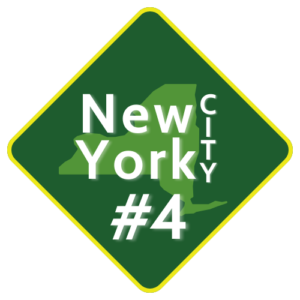 New York City has long been known for its beautiful city skyline, and now it’s known for its sky-high verdicts too. Nuclear verdicts burden businesses in the city and bog down economic growth. Liability-expanding laws have led to a never-ending surge of meritless lawsuits in courts across the state and third-party litigation financing feeds the city’s litigation machine.
New York City has long been known for its beautiful city skyline, and now it’s known for its sky-high verdicts too. Nuclear verdicts burden businesses in the city and bog down economic growth. Liability-expanding laws have led to a never-ending surge of meritless lawsuits in courts across the state and third-party litigation financing feeds the city’s litigation machine.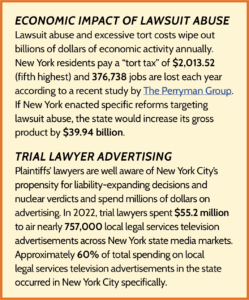 a blind eye to the deteriorating civil justice climate, and rather looks for ways to expand liability by pursuing a pro- plaintiff agenda. It continues to consider legislation that, if enacted, will further entrench New York City on the Judicial Hellholes® report for years to come.
a blind eye to the deteriorating civil justice climate, and rather looks for ways to expand liability by pursuing a pro- plaintiff agenda. It continues to consider legislation that, if enacted, will further entrench New York City on the Judicial Hellholes® report for years to come.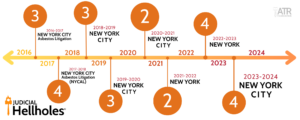



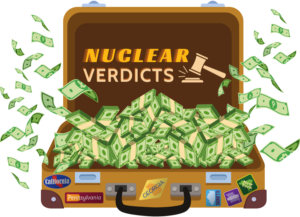 New York City continues to see a surging number of nuclear verdicts, obtained by plaintiffs’ lawyers who use manipulation tactics like “reptile theory” and “anchoring” to drive up awards using New York’s generous liability laws.
New York City continues to see a surging number of nuclear verdicts, obtained by plaintiffs’ lawyers who use manipulation tactics like “reptile theory” and “anchoring” to drive up awards using New York’s generous liability laws.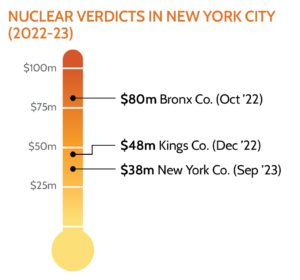
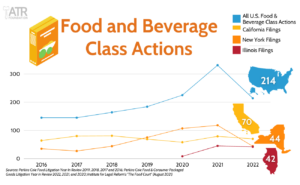
 New York has now
New York has now  In March 2023, the U.S. Supreme Court agreed to decide whether serial “testers,” individuals who bring suits against numerous entities for alleged violations of the ADA without necessarily planning on using the service, have standing to sue. The question regarding standing turns on whether the plaintiff suffered a “sufficiently concrete injury.” While the case targeted a hotel in Maine, the outcome could have significant implications for such cases in New York and nationwide.
In March 2023, the U.S. Supreme Court agreed to decide whether serial “testers,” individuals who bring suits against numerous entities for alleged violations of the ADA without necessarily planning on using the service, have standing to sue. The question regarding standing turns on whether the plaintiff suffered a “sufficiently concrete injury.” While the case targeted a hotel in Maine, the outcome could have significant implications for such cases in New York and nationwide.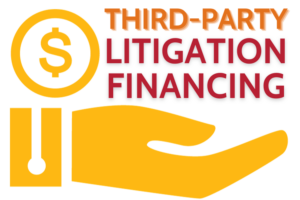 Plaintiffs’ lawyers are not the only ones profiting off litigation in New York City. An industry offers “pre-settlement” funding or advances, which prey on vulnerable consumers, while making it more difficult to resolve cases for rea- sonable amounts.
Plaintiffs’ lawyers are not the only ones profiting off litigation in New York City. An industry offers “pre-settlement” funding or advances, which prey on vulnerable consumers, while making it more difficult to resolve cases for rea- sonable amounts.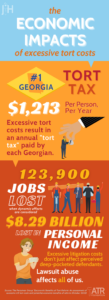 In April 2023, Adrian Alexander, a New York litigation funder, was sentenced to
In April 2023, Adrian Alexander, a New York litigation funder, was sentenced to  New York City saw
New York City saw 

